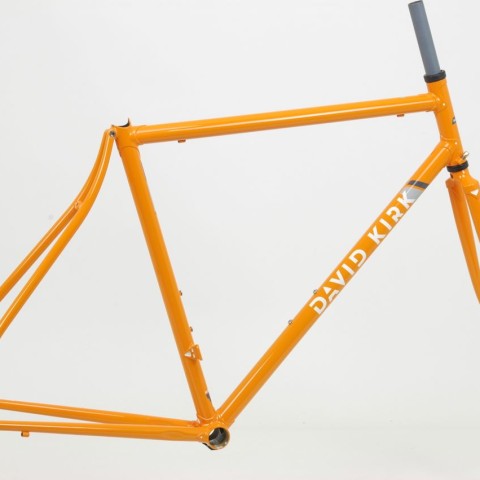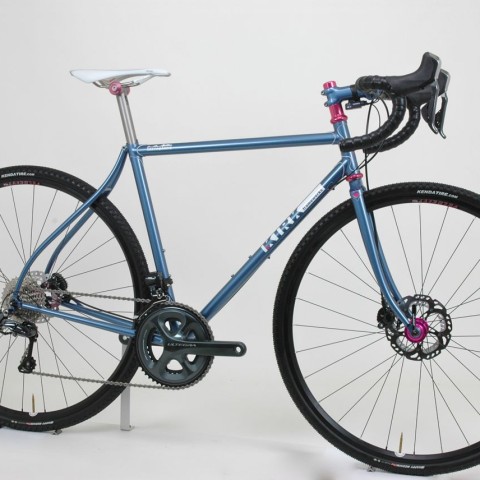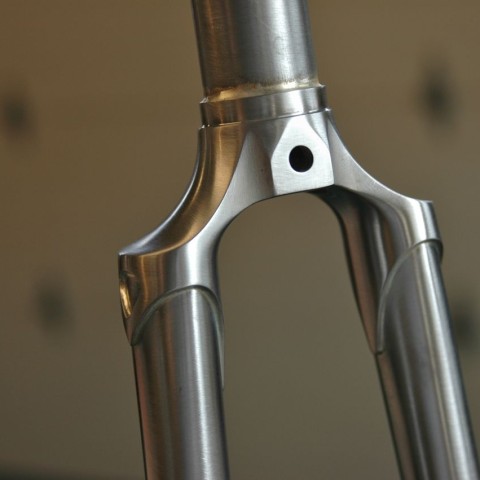Forks? Why build forks?
I occasionally get asked by riders and other builders why I build my own forks and honestly this strikes me as an odd question. I suppose this a result of the way the fork is looked at in terms of bike design at this point…forks are all too often looked at like any other component on a bike like a headset or a hub and not as what it truly is – an integral part of a frame and fork set that is designed to fit the rider and the end use of the bike and to compliment each other giving proper handling and road feel.
Going back a few decades, before the advent of the one-size-fits-all carbon road fork, most everyone that made a frame also made a fork that specifically matched that frame. At that time the forks were typically steel and they were built to compliment the ride and handling of the steel frame they were matched to. At some point titanium became a popular frame material it was at about this time that the aftermarket carbon fork came into being. The carbon fork was light and matched the space-age look and feel of a Ti frame and it was a perfect marriage…or not. Some still preferred having a steel fork that was matched in stiffness and geometry to their Ti frame but most were counting grams and wanted a super light fork to match their light frame. This was the era where, for the first time, mainstream builders bought a fork from a third party to sell with the frame they designed and built instead of building the fork themselves. From a production standpoint this was more than understandable as it freed up the time and craftsman to build more frames and better add to the bottom line. This of course is not a bad thing and there is nothing evil about profit but like anything it came at a cost.
The cost in this case was the loss of the “frameset” – customers no longer bought a frameset but instead bought an unmatched frame and a fork and used them together. If you are in the middle of the size/weight bell curve this could work out fine – however if you occupied either end of the bell curve, or wanted something other than a straight up road race bike, then you often got the short end of the stick. The problem is that most aftermarket forks come in only one rake and in only one stiffness – and the reason for this is simple – money. Designing and cutting a mold for a mass produced fork is very expensive and most of the forks sold will be in the middle of the bell curve so most makers don’t bother to make molds for the ends of the curve. This means that every bike gets the same fork rake and that every fork is built to be stiff and strong enough for the largest and heaviest rider that might every ride that fork. This is hardly optimum if you are 5’3” and 105 pounds but with rare exceptions this is what riders have to deal with.
Smaller and lighter riders really get the shit end of the stick on this one for a few reasons and tall and light guys also lose out on this one too. It all makes sense when you look at how frames are designed for riders at the ends of the bell curve. Small riders get shallow head angles to keep their toes away from the front tire and to give proper handling they really need a fork with much more than the standard 43 mm of rake to give a trail number that will allow the bike to handle as it should. Generally we are looking for the trail to be in the 56 – 60 mm range to give good handling yet all too many bikes that use a one-size-fits-all fork with its 43ish mm of rake end up with a trail number pushing 70 mm or more. Bikes like this can be awful to ride with low speed wheel flop when climbing and the feeling like the rider needs to move their weight forward during turns to get the bike to go in the direction they want. Combine this with the fact that this fork used by the small and light rider is designed to deal with someone who weighs upward of 275 lbs and you get a pretty lousy combination of handling and ride quality. Yet most riders who suffer through using a bike like this have never ridden a bike that has a “frameset” designed to work as a whole. When they finally get on a bike that uses a fork designed for their weight and to work with the frame’s head angle it’s a revelation.
Aside from rake and stiffness there are other reasons to build the frame and fork together and to buy them as a frameset – proper tire clearance for fatter tires and long reach brakes, proper alignment (when a fork comes out of the mold it is what it is and it’s way too common to have a fork that is off to one side), proper length or span to keep the frame angles what they should be, braze-ons for racks or bags or lights….etc.
The above is a long way of saying why every frame I build has a fork built specifically to match that frame and to the size and weight of the rider, as well as how and where the complete bike will be used. This is the only was to assure that the bike will handle and ride as it should. Unfortunately it is no longer the case that a handbuilt frame will come with a made-to-match fork as even some renown builders have gone to making one-size-fits-all forks en masse to make life easier – it saves time and money and in the end profit is important. But there is always a cost.
I’ll end with this – if you are shopping for a new frame be sure to look not just for a frame and fork but instead look for a “frameset” that was designed to work for you. This no doubt will come with a fork that was designed to work as it should with the frame and for you.



Share this Article:




Leave a Reply
You must be logged in to post a comment.